Targeting Lane-Level Map Matching for Smart Vehicles: Construction of High-Definition Road Maps Based on GIS
Abstract
1. Introduction
- This study proposes a systematic framework and effective method for constructing high-definition maps using road edge data obtained from GIS maps. Through extracting the road centerline and the lane line and detailed expression of the topological relationship between nodes and lanes, a lane-level road network can be built. The proposed framework provides a low-cost and high-efficiency method for building lane-level road maps to support various smart city applications and refined traffic management.
- To further examine the feasibility of the constructed maps, a lane-level trajectory matching test is then conducted by taking the urban area of Pingshan District in Shenzhen, China as an example. The constructed lane-level maps based on the GIS could provide strong support for smart vehicle applications and lane-level traffic information management.
2. System Framework for GIS-Based Map Construction
2.1. Road Layer
2.2. Lane Layer
2.3. Intersection Connection Layer
3. Map Construction Method
3.1. Road Centerline Extraction
3.1.1. Constructing Constrained Delaunay Triangulation
3.1.2. Road Division
3.1.3. Road Centerline Generation
3.2. Lane-Level Network Construction
4. Experiment and Application: Lane-Level Trajectory Matching
4.1. Construction of a Lane-Level Road Network in Shenzhen
4.2. Lane-Level Trajectory Matching
4.2.1. Trajectory Matching in Road Segment Domains
4.2.2. Trajectory Matching in the Intersection Domain
4.2.3. Trajectory Matching Test
5. Conclusions
Author Contributions
Funding
Institutional Review Board Statement
Informed Consent Statement
Data Availability Statement
Conflicts of Interest
References
- Liu, J.; Wu, H.; Guo, C.; Zhang, H.; Zuo, W.; Yang, C. Progress and Consideration of High Precision Road Navigation Map. Chin. J. Eng. Sci. 2018, 20, 99. [Google Scholar] [CrossRef]
- Gruyer, D.; Belaroussi, R.; Revilloud, M. Accurate lateral positioning from map data and road marking detection. Expert Syst. Appl. 2016, 43, 1–8. [Google Scholar] [CrossRef]
- Matthaei, R.; Bagschik, G.; Maurer, M. Map-Relative Localization in Lane-Level Maps for ADAS and Autonomous Driving; IEEE: Piscataway, NJ, USA, 2014; ISBN 9781479936373. [Google Scholar]
- Liu, C.; Jiang, K.; Yang, D.; Xiao, Z. Design of a Multi-layer Lane-Level Map for Vehicle Route Planning. MATEC Web Conf. 2017, 124, 3001. [Google Scholar] [CrossRef]
- Chaoran, L.; Kun, J.; Zhongyang, X.; Zhong, C.; Diange, Y. Lane-Level Route Planning Based on a Multi-Layer Map Model; IEEE: Piscataway, NJ, USA, 2017; ISBN 978-1-5386-1526-3. [Google Scholar]
- Zheng, L.; Song, H.; Li, B.; Zhang, H. Generation of Lane-Level Road Networks Based on a Trajectory-Similarity-Join Pruning Strategy. IJGI 2019, 8, 416. [Google Scholar] [CrossRef]
- Fernandez, F.; Sanchez, A.; Velez, J.F.; Moreno, B. Associated Reality: A cognitive Human–Machine Layer for autonomous driving. Robot. Auton. Syst. 2020, 133, 103624. [Google Scholar] [CrossRef]
- Zheng, L.; Li, B.; Yang, B.; Song, H.; Lu, Z. Lane-Level Road Network Generation Techniques for Lane-Level Maps of Autonomous Vehicles: A Survey. Sustainability 2019, 11, 4511. [Google Scholar] [CrossRef]
- Arman, M.A.; Tampère, C.M.J. Lane-level routable digital map reconstruction for motorway networks using low-precision GPS data. Transp. Res. Part C Emerg. Technol. 2021, 129, 103234. [Google Scholar] [CrossRef]
- Jo, K.; Sunwoo, M. Generation of a Precise Roadway Map for Autonomous Cars. IEEE Trans. Intell. Transp. Syst. 2014, 15, 925–937. [Google Scholar] [CrossRef]
- Gwon, G.-P.; Hur, W.-S.; Kim, S.-W.; Seo, S.-W. Generation of a Precise and Efficient Lane-Level Road Map for Intelligent Vehicle Systems. IEEE Trans. Veh. Technol. 2017, 66, 4517–4533. [Google Scholar] [CrossRef]
- Bender, P.; Ziegler, J.; Stiller, C. Lanelets: Efficient Map Representation for Autonomous Driving. In Proceedings of the IEEE Intelligent Vehicles Symposium Proceedings, Dearborn, MI, USA, 8–11 June 2014; IEEE: Piscataway, NJ, USA, 2014. ISBN 9781479936373. [Google Scholar]
- Ghallabi, F.; Nashashibi, F.; El-Haj-Shhade, G.; Mittet, M.-A. Dynamic Strategies Optimizing Benefits of Fully Autonomous Shared Vehicle Fleets LIDAR-Based Lane Marking Detection For Vehicle Positioning in an HD Map; IEEE: Piscataway, NJ, USA, 2018; ISBN 9781728103235. [Google Scholar]
- Hata, A.Y.; Wolf, D.F. Feature Detection for Vehicle Localization in Urban Environments Using a Multilayer LIDAR. IEEE Trans. Intell. Transp. Syst. 2016, 17, 420–429. [Google Scholar] [CrossRef]
- Jiménez, F.; Clavijo, M.; Castellanos, F.; Álvarez, C. Accurate and Detailed Transversal Road Section Characteristics Extraction Using Laser Scanner. Appl. Sci. 2018, 8, 724. [Google Scholar] [CrossRef]
- Yang, B.; Fang, L.; Li, Q.; Li, J. Automated Extraction of Road Markings from Mobile Lidar Point Clouds. Photogramm. Eng. Remote Sens. 2012, 78, 331–338. [Google Scholar] [CrossRef]
- Yan, L.; Liu, H.; Tan, J.; Li, Z.; Xie, H.; Chen, C. Scan Line Based Road Marking Extraction from Mobile LiDAR Point Clouds. Sensors 2016, 16, 903. [Google Scholar] [CrossRef] [PubMed]
- Guan, H.; Li, J.; Yu, Y.; Wang, C.; Chapman, M.; Yang, B. Using mobile laser scanning data for automated extraction of road markings. ISPRS J. Photogramm. Remote Sens. 2014, 87, 93–107. [Google Scholar] [CrossRef]
- He, M.; Rajkumar, R.R. LaneMatch: A Practical Real-Time Localization Method Via Lane-Matching. IEEE Robot. Autom. Lett. 2022, 7, 4408–4415. [Google Scholar] [CrossRef]
- Li Xiang, L.H.N. A trajectory-oriented carriageway-based road network data model, part 1: Background. Geo-Spat. Inf. Sci. 2006, 9, 65–70. [Google Scholar] [CrossRef]
- Li Xiang, L.H.N. A trajectory-oriented carriageway-based road network data model, part 3: Implementation. Geo-Spat. Inf. Sci. 2006, 9, 201–205. [Google Scholar] [CrossRef]
- Li Xiang, L.H.N. A trajectory-oriented carriageway-based road network data model, Part 2: Methodology. Geo-Spat. Inf. Sci. 2006, 9, 112–117. [Google Scholar] [CrossRef]
- Li, C.; Yin, Y.; Wu, P.; Wu, W. Skeleton Line Extraction Method in Areas with Dense Junctions Considering Stroke Features. IJGI 2019, 8, 303. [Google Scholar] [CrossRef]
- Lewandowicz, E.; Flisek, P. A Method for Generating the Centerline of an Elongated Polygon on the Example of a Watercourse. IJGI 2020, 9, 304. [Google Scholar] [CrossRef]
- Curtin, K.M.; Nicoara, G.; Arifin, R.R. A Comprehensive Process for Linear Referencing. URISA J. 2007, 19, 23–32. [Google Scholar]
- Sajeed, M.A.; Kelouwani, S.; Amamou, A.; Alam, M.Z.; Agbossou, K. Vehicle Lane Departure Estimation on Urban Roads Using GIS Information, Proceedings of the 2021 IEEE Vehicle Power and Propulsion Conference (VPPC), Gijon, Spain, 25–28 October 2021; IEEE: Piscataway, NJ, USA, 2021; pp. 1–7. ISBN 978-1-6654-0528-7. [Google Scholar]
- Shin, D.; Park, K.-m.; Park, M. High Definition Map-Based Localization Using ADAS Environment Sensors for Application to Automated Driving Vehicles. Appl. Sci. 2020, 10, 4924. [Google Scholar] [CrossRef]
- Kang, J.M.; Yoon, T.S.; Kim, E.; Park, J.B. Lane-Level Map-Matching Method for Vehicle Localization Using GPS and Camera on a High-Definition Map. Sensors 2020, 20, 2166. [Google Scholar] [CrossRef] [PubMed]
- Jiang, K.; Yang, D.; Liu, C.; Zhang, T.; Xiao, Z. A Flexible Multi-Layer Map Model Designed for Lane-Level Route Planning in Autonomous Vehicles. Engineering 2019, 5, 305–318. [Google Scholar] [CrossRef]
- Zhang, T.; Arrigoni, S.; Garozzo, M.; Yang, D.-g.; Cheli, F. A lane-level road network model with global continuity. Transp. Res. Part C Emerg. Technol. 2016, 71, 32–50. [Google Scholar] [CrossRef]
- Zhang, C.; Li, Y.; Xiang, L.; Jiao, F.; Wu, C.; Li, S. Generating Road Networks for Old Downtown Areas Based on Crowd-Sourced Vehicle Trajectories. Sensors 2021, 21, 235. [Google Scholar] [CrossRef]
- Paul Chew, L. Constrained Delaunay Triangulations. Algorithmica 1989, 4, 97–108. [Google Scholar] [CrossRef]
- Li, C.; Yin, Y.; Wu, P.; Liu, X.; Guo, P. Improved Jitter Elimination and Topology Correction Method for the Split Line of Narrow and Long Patches. IJGI 2018, 7, 402. [Google Scholar] [CrossRef]
- Zuo, Z.; Yang, L.; An, X.; Zhen, W.; Qian, H.; Dai, S. A Hierarchical Matching Method for Vectorial Road Networks Using Delaunay Triangulation. IJGI 2020, 9, 509. [Google Scholar] [CrossRef]
- Tsai, V.J.D. Delaunay triangulations in TIN creation: An overview and a linear-time algorithm. Int. J. Geogr. Inf. Syst. 1993, 7, 501–524. [Google Scholar] [CrossRef]
- Chen, L.; Qin, D.; Xu, X.; Cai, Y.; Xie, J. A path and velocity planning method for lane changing collision avoidance of intelligent vehicle based on cubic 3-D Bezier curve. Adv. Eng. Softw. 2019, 132, 65–73. [Google Scholar] [CrossRef]
- Zhang, F.; Xia, R.; Chen, X. An optimal trajectory planning algorithm for autonomous trucks: Architecture, algorithm, and experiment. Int. J. Adv. Robot. Syst. 2020, 17, 172988142090960. [Google Scholar] [CrossRef]
- Asghar, R.; Garzon, M.; Lussereau, J.; Laugier, C. Vehicle Localization Based on Visual Lane Marking and Topological Map Matching; IEEE: Piscataway, NJ, USA, 2020; ISBN 9781728173955. [Google Scholar]



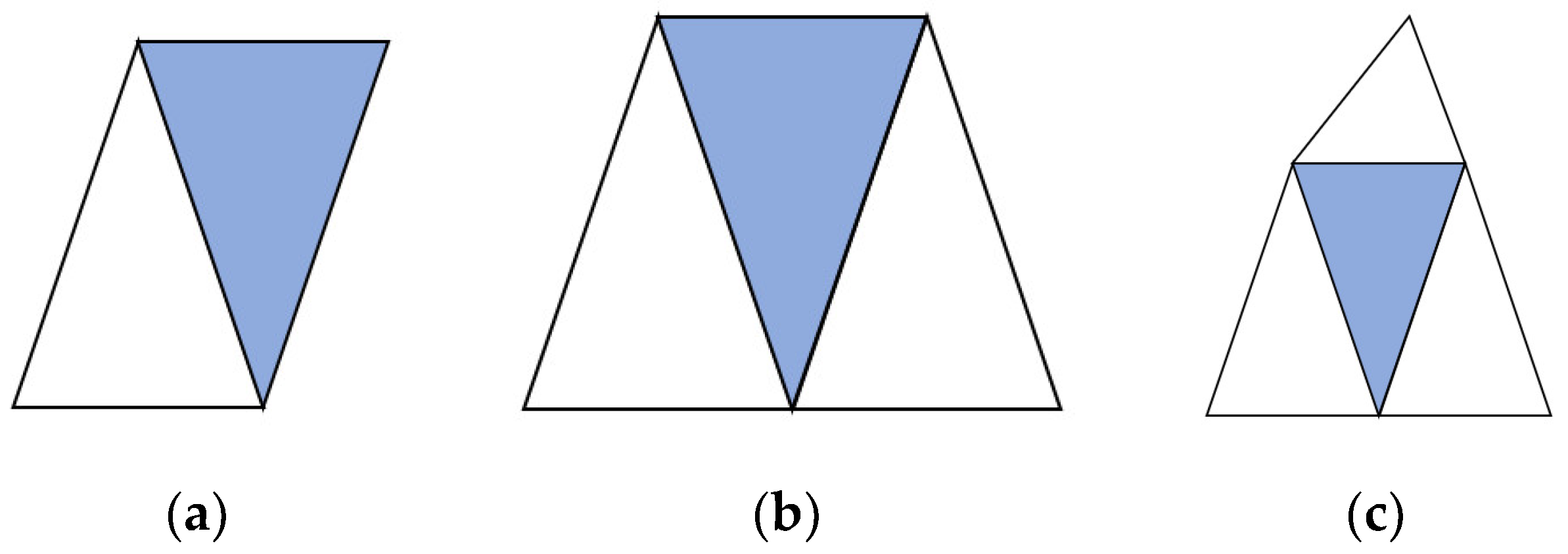



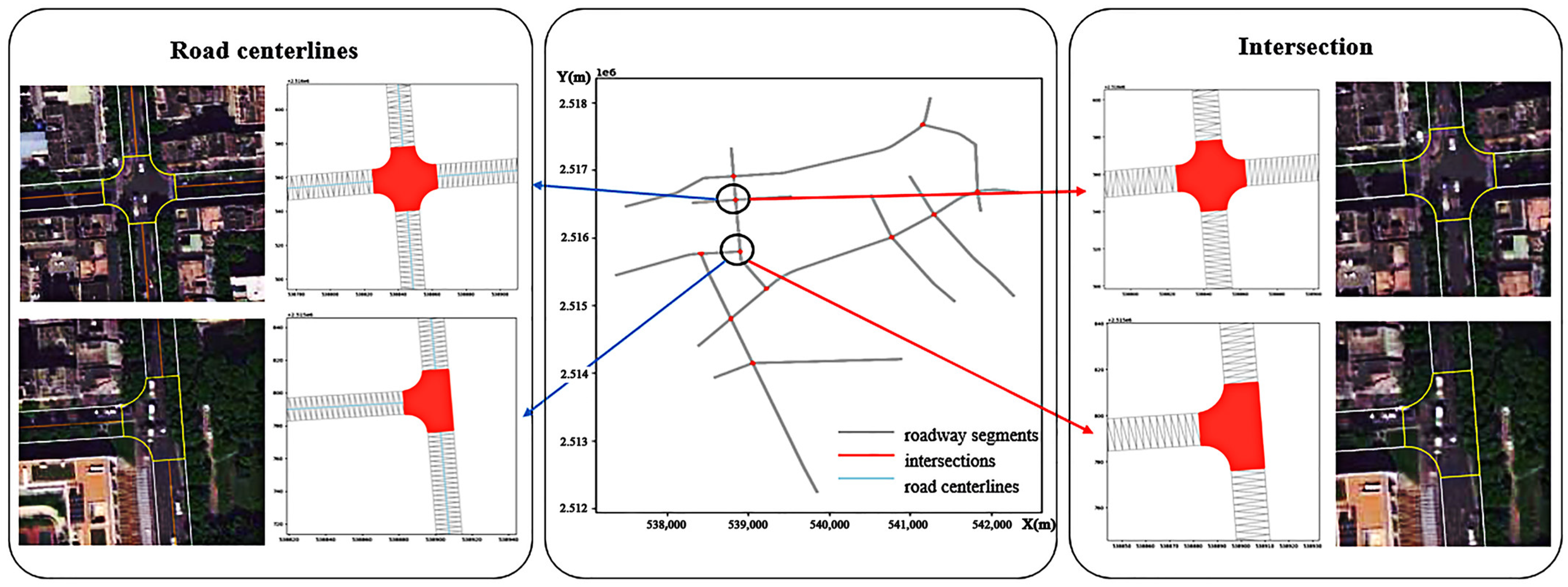
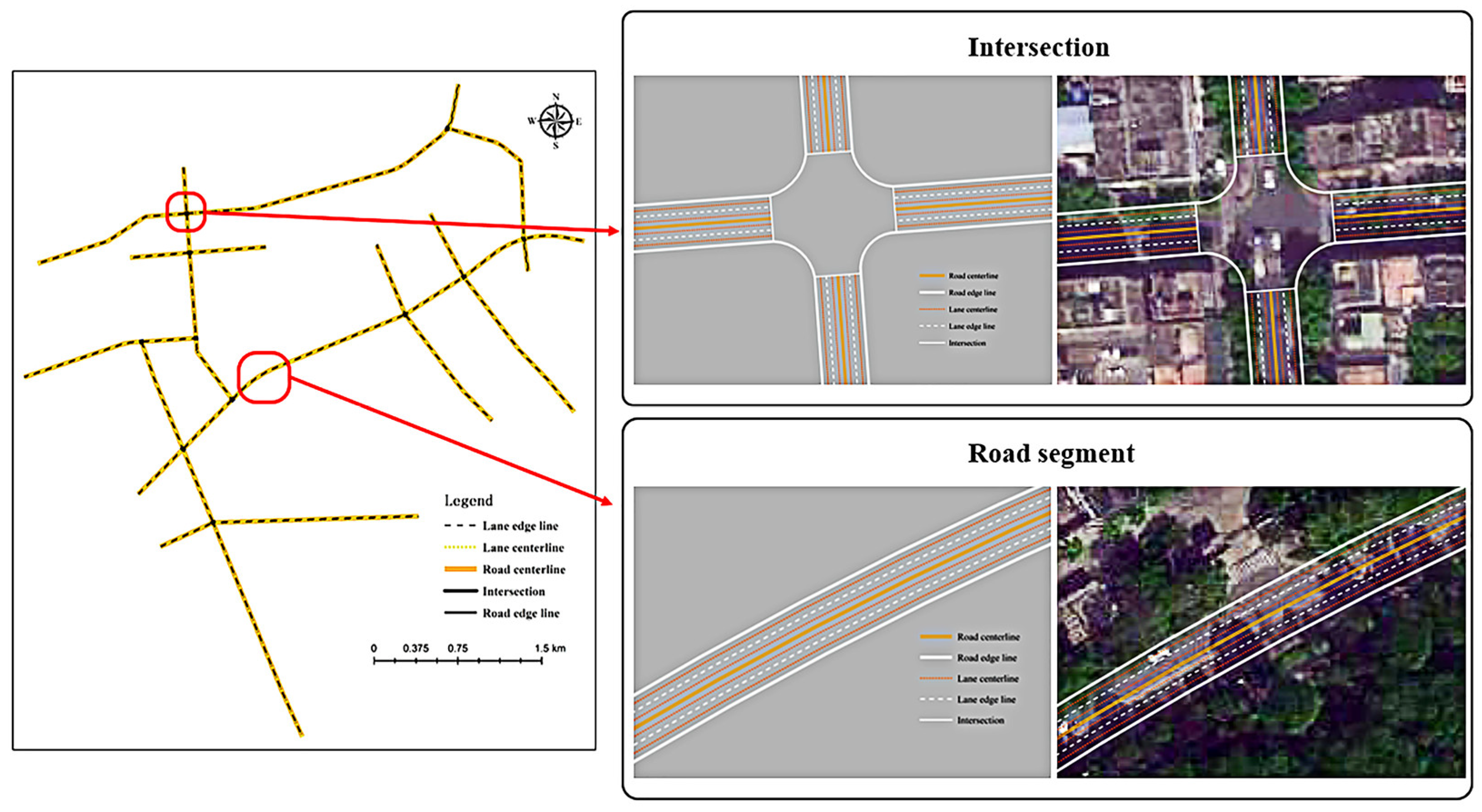
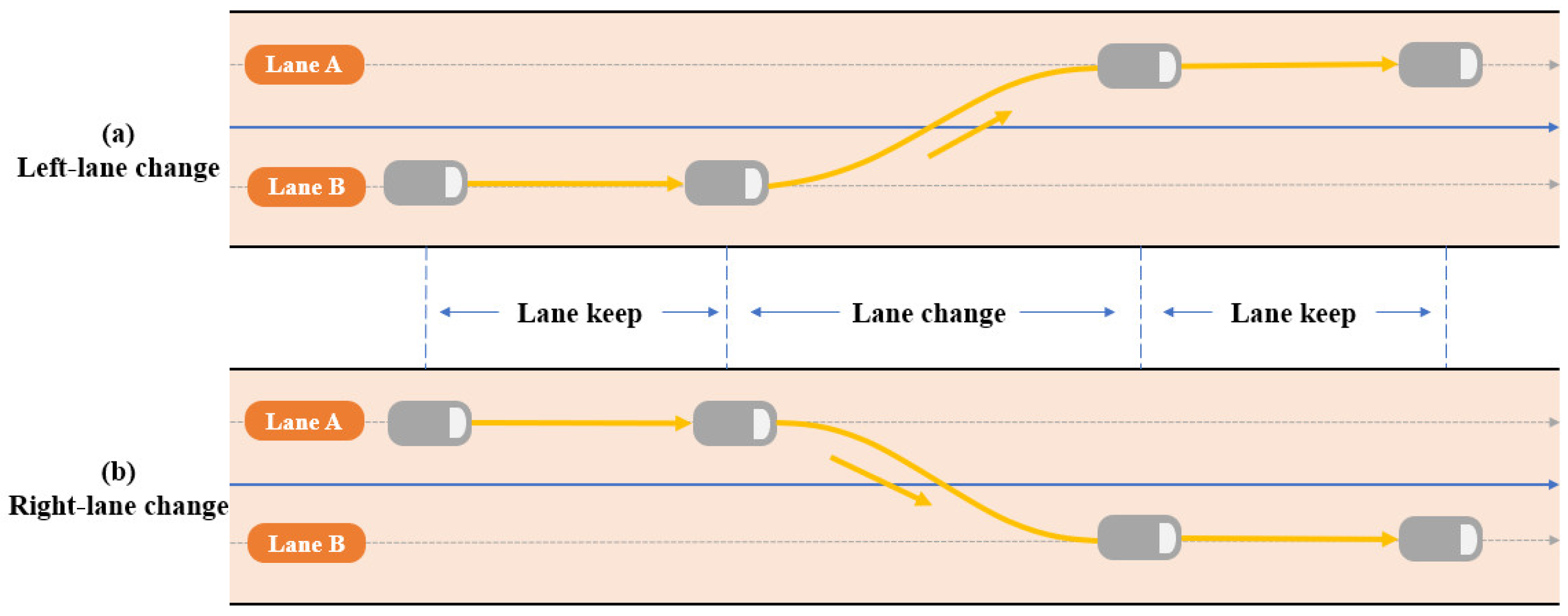

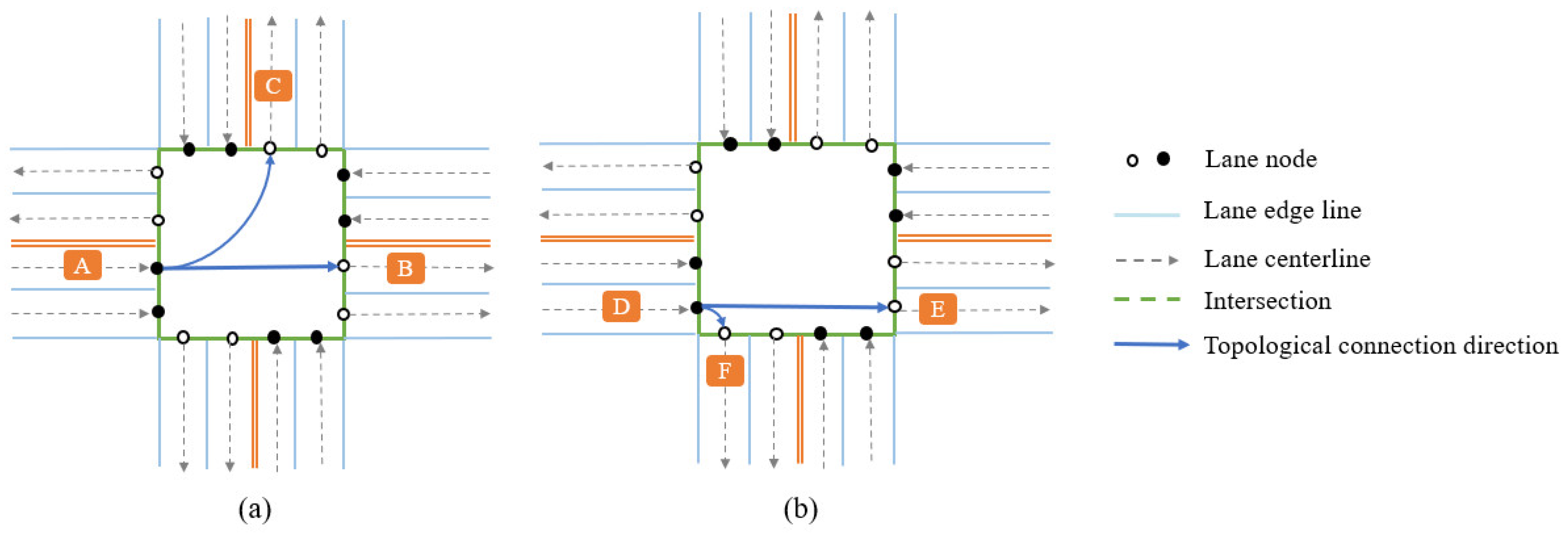
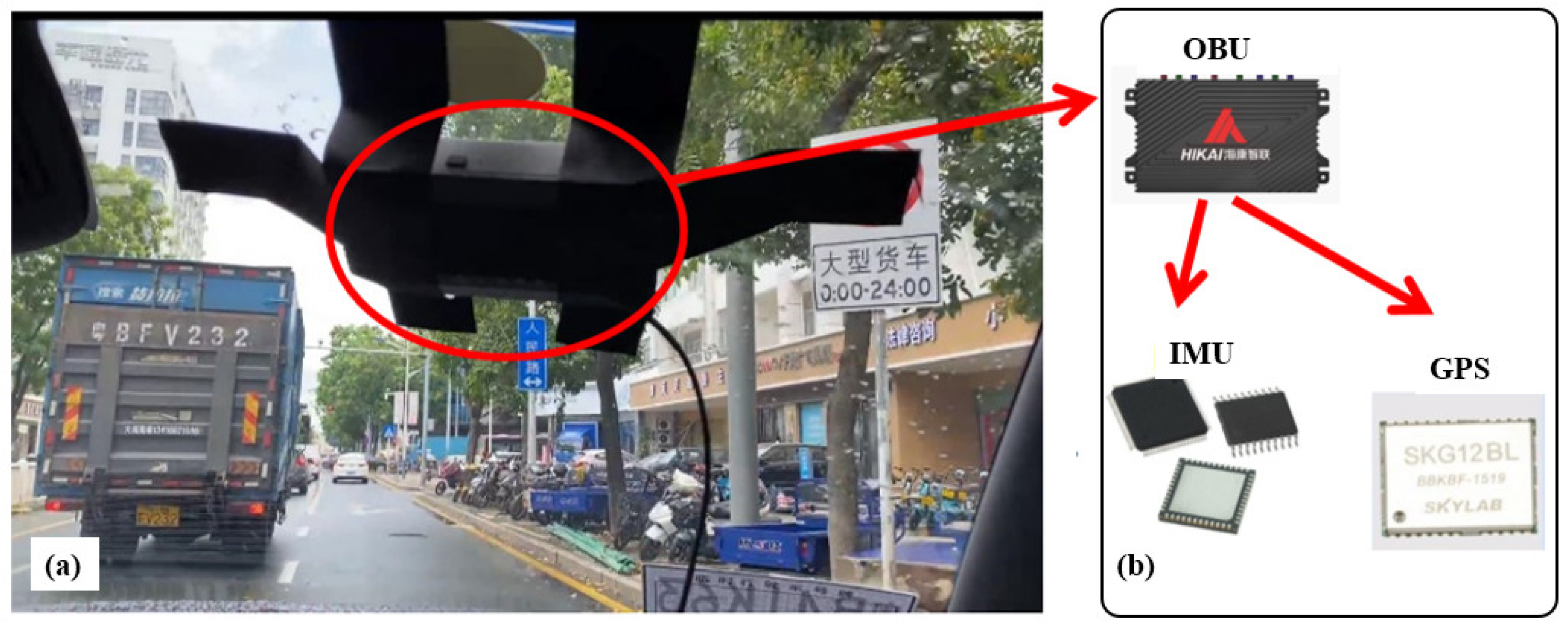

| Trajectory | Distance | Trajectory Points | Matching Accuracy |
|---|---|---|---|
| 1 | 4.7 km | 9284 | 97.59% |
| 2 | 4.3 km | 5644 | 96.98% |
| Overall | 9 km | 14,928 | 97.34% |
Disclaimer/Publisher’s Note: The statements, opinions and data contained in all publications are solely those of the individual author(s) and contributor(s) and not of MDPI and/or the editor(s). MDPI and/or the editor(s) disclaim responsibility for any injury to people or property resulting from any ideas, methods, instructions or products referred to in the content. |
© 2023 by the authors. Licensee MDPI, Basel, Switzerland. This article is an open access article distributed under the terms and conditions of the Creative Commons Attribution (CC BY) license (https://creativecommons.org/licenses/by/4.0/).
Share and Cite
Lei, T.; Xiao, G.; Yin, X. Targeting Lane-Level Map Matching for Smart Vehicles: Construction of High-Definition Road Maps Based on GIS. Appl. Sci. 2023, 13, 862. https://doi.org/10.3390/app13020862
Lei T, Xiao G, Yin X. Targeting Lane-Level Map Matching for Smart Vehicles: Construction of High-Definition Road Maps Based on GIS. Applied Sciences. 2023; 13(2):862. https://doi.org/10.3390/app13020862
Chicago/Turabian StyleLei, Tian, Gaoyao Xiao, and Xiaohong Yin. 2023. "Targeting Lane-Level Map Matching for Smart Vehicles: Construction of High-Definition Road Maps Based on GIS" Applied Sciences 13, no. 2: 862. https://doi.org/10.3390/app13020862
APA StyleLei, T., Xiao, G., & Yin, X. (2023). Targeting Lane-Level Map Matching for Smart Vehicles: Construction of High-Definition Road Maps Based on GIS. Applied Sciences, 13(2), 862. https://doi.org/10.3390/app13020862






